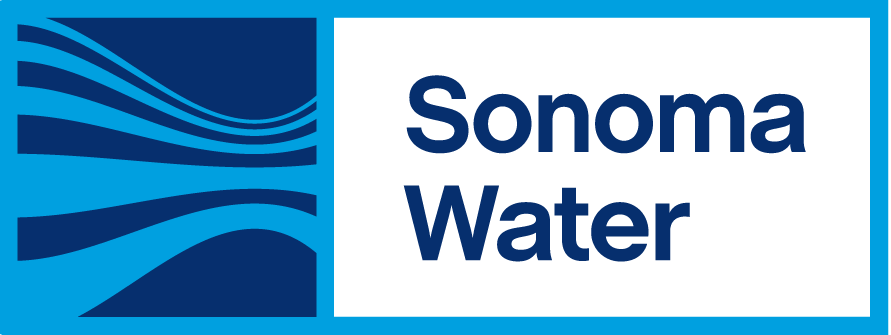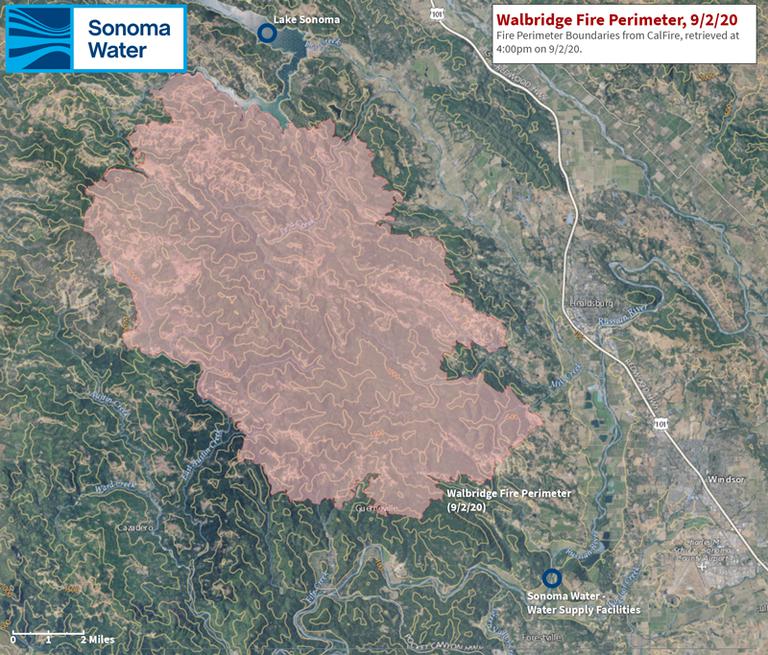Walbridge and Meyers Fires, August 2020
A Message From Grant Davis, General Manager:
The Walbridge Fire has not impacted Sonoma Water’s water supply facilities at this time. Tap water provided by Sonoma Water is safe to drink. There has been no impact to our system’s drinking water quality.
Sonoma Water employees are safely attending to our facilities to ensure water supply systems remain functional and continue to provide our community with ongoing, high quality drinking water. In fact, a group of Sonoma Water employees performed vegetation management around critical facilities to help firefighters if the Walbridge Fire reaches our facilities.
Regarding the fire's potential impacts to Lake Sonoma, we are monitoring and coordinating with the U.S. Army Corps of Engineers on fire response. Read below about how Lake Sonoma is a critical water supply storage facility for our system.
We remain vigilant and are coordinating with the appropriate responding agencies including the CalFire and the County’s Office of Emergency Services. Our hearts are heavy for those of our community who have lost their homes, and we thank the tremendous efforts of our first responders. Please stay safe and follow official evacuation orders.
Grant Davis
General Manager
Update 8/27/20: Emergency Water Conservation Request is Lifted
The Walbridge Fire has stabilized, weather conditions are favorable, and Sonoma Water’s water supply facilities are no longer in any immediate danger. As it has been throughout the fire emergency, our water is safe and we have experienced no issues with water quality or deliveries.
Therefore, we are lifting the Emergency Water Conservation Request that was issued at the beginning of the fires. Thank you to all our customers for saving water during the fire emergency. Your efforts are appreciated.
The response to the emergency conservation request was immediate and impressive. Together, we saved millions of gallons of water that allowed greater water storage for firefighting and emergency supplies.
But our water conservation efforts must continue. There is never enough water to waste. We have just had one of the driest rain years on record, and water conservation is something we can make part of our everyday lives.
For tips on how to save water both inside and outside of your home, please visit: www.savingwaterpartnership.org
Lake Sonoma Watershed – It’s importance and role in our drinking water
- There is no current impact to Sonoma Water’s water supply system or water quality. Tap water is safe to drink.
- The fire is currently impacting the southern edge of the Lake Sonoma watershed. Sonoma Water is planning on the potential for impacts to its water supply system if the fire continues into the Lake Sonoma watershed.
- Sonoma Water relies on Lake Sonoma to hold and release water for water supply, flood control purposes and meeting minimum instream flow requirements in the Lower Russian River.
- Water released from Warm Springs Dam travels approximately 20 miles through Dry Creek and the Russian River before it reaches Sonoma Water’s water supply facilities located along the Russian River near Forestville. Sonoma Water’s water supply facilities divert Russian River underflow that is filtered and treated by the alluvial sands and gravels adjacent to and beneath the Russian River.
- Sonoma Water has been collaborating for nearly two decades with researchers at the United States Geological Survey and Lawrence Berkeley National Lab to understand the complex mechanisms that remove pathogens and other contaminants of concern by the alluvial sands and gravels.
- Wildfires can contaminate nearby streams and watersheds through mobilization of sediments, nutrients and dissolved organic matter, straining the capabilities of downstream municipal treatment facilities (Source: CU Boulder)
- Current research indicates that fires can degrade surface water quality through erosion, ash deposition, increased sediment loads and/or elevated nutrient runoff (i.e., nitrogen and phosphorus) that can spur algal blooms. (Source)
- Sonoma Water is coordinating closely with the County’s Emergency Operations Center along with its water contractors to ensure water quality is not impacted by the region’s fires.
- Sonoma Water conducts extensive water quality testing to ensure all state and federal water quality standards are met.
- Sonoma Water will continue to monitor water quality, fire conditions and coordinate with the appropriate emergency responders to ensure our water supply system remains safe.
2017 Fire Response
Sonoma Water is working in collaboration with organizations throughout Sonoma County to protect our watersheds and water supply from adverse impacts due to the October 2017 wildfires. Sonoma Water staff are assisting in the regional effort to identify potential risks the fires have posed to our watersheds, and are taking actions to monitor and mitigate those risks.
Water Quality Monitoring and Erosion Control
Sonoma Water is working to ensure that Sonoma County residents continue to have a clean, reliable supply of drinking water. Fortunately, the fires minimally impacted the parts of the Russian River watershed which supply drinking water for Sonoma Water. Sonoma Water staff are working with a collaborative group of government agencies including the County of Sonoma, Resource Conservation Districts, and the City of Santa Rosa, and non-profits including the Sonoma Ecology Center to install wattles, sandbags, and other erosion control methods. Erosion control techniques prevent sediment and debris from entering waterways and storm drains.
View more information about erosion control.
To continually protect our water supply and monitor the effects of the fire on the environment, Sonoma Water has partnered with the North Coast Regional Water Control Board, United States Geological Survey, and Lawrence Berkeley National Laboratory to perform extensive water quality monitoring in waterways in and around burn areas.
Risk of Flash Floods, Mudflows, and Debris Flows
Wildfires dramatically increase the risk of flash floods, mudflows, and debris flows by eliminating vegetation and other obstacles which slow runoff and promote infiltration of rainwater into the ground and altering the soil to repel water. These threats can be unpredictable, move quickly, and can carry boulders, trees, mud and debris at high speeds. The National Weather Service’s (NWS) general rule of thumb is that half an inch of rain in an hour can cause flash flooding in areas affected by fires.
In preparation for anticipated rains, Sonoma Water has partnered with the National Weather Service to monitor potential flood threats. The Early Warning Forecast and Response System will provide information to the National Weather Service, enhancing their ability to send out local advisories, alerts, and warnings to areas where fires have increased the risk of flash flooding, debris flows, and landslides.
This program will include the following:
- Installation of additional stream and rainfall gauges that will detect conditions which may lead to flash floods, mud slides, or debris flows.
- Installation of an X-band radar unit that will provide accurate, localized detection of weather patterns to help predict when storm events may cause flash flooding, mud slides and debris flows. This radar unit is being installed as part of the AQPI project (learn more here).
View more information on hazard risk and mitigation.
View the Sonoma.OneRain.com website for an interactive map with live data from county-wide streamflow and rainfall gauges

